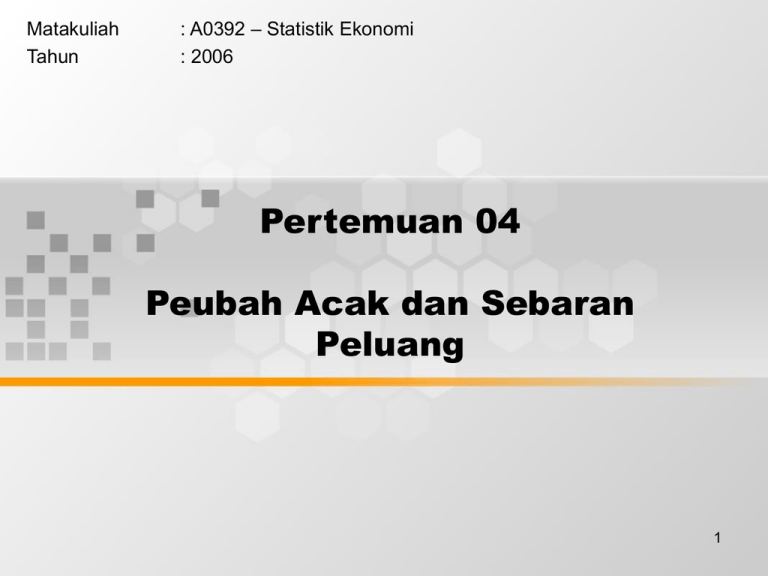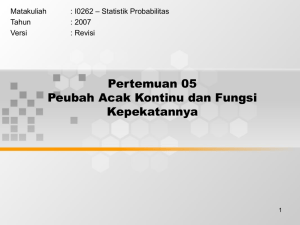Pertemuan 04 Peubah Acak dan Sebaran Peluang – Statistik Ekonomi
advertisement

Matakuliah Tahun : A0392 – Statistik Ekonomi : 2006 Pertemuan 04 Peubah Acak dan Sebaran Peluang 1 Outline Materi: • Peubah acak diskrit • Nilai harapan peubah acak • Varians dan kovarians peubah acak diskrit 2 Basic Business Statistics (9th Edition) Some Important Discrete Probability Distributions 3 Peubah Acak Diskrit dan Sebaran Peluang • The Probability of a Discrete Random Variable • Covariance and Its Applications in Finance • Binomial Distribution • Poisson Distribution • Hypergeometric Distribution 4 Random Variable • Random Variable – Outcomes of an experiment expressed numerically – E.g., Toss a die twice; count the number of times the number 4 appears (0, 1 or 2 times) – E.g., Toss a coin; assign $10 to head and $30 to a tail = $10 T = -$30 5 Discrete Random Variable • Discrete Random Variable – Obtained by counting (0, 1, 2, 3, etc.) – Usually a finite number of different values – E.g., Toss a coin 5 times; count the number of tails (0, 1, 2, 3, 4, or 5 times) 6 Discrete Probability Distribution Example Event: Toss 2 Coins Count # Tails Probability Distribution Values Probability T T T T 0 1/4 = .25 1 2/4 = .50 2 1/4 = .25 This is using the A Priori Classical Probability approach. 7 Discrete Probability Distribution • List of All Possible [Xj , P(Xj) ] Pairs – Xj = Value of random variable – P(Xj) = Probability associated with value • Mutually Exclusive (Nothing in Common) • Collective Exhaustive (Nothing Left Out) 0 PX j 1 PX 1 j 8 Summary Measures • Expected Value (The Mean) – Weighted average of the probability distribution – E X X jP X j j – E.g., Toss 2 coins, count the number of tails, compute expected value: X jP X j j 0 .25 1.5 2 .25 1 9 Summary Measures (continued) • Variance – Weighted average squared deviation about the mean 2 – 2 E X 2 X P X j j – E.g., Toss 2 coins, count number of tails, compute variance: X j P X j 2 2 0 1 .25 1 1 .5 2 1 .25 2 .5 2 2 10 Covariance and Its Application N XY X i E X Yi E Y P X iYi i 1 X : discrete random variable X i : i th outcome of X Y : discrete random variable Yi : i th outcome of Y P X iYi : probability of occurrence of the i th outcome of X and the i th outcome of11Y Computing the Mean for Investment Returns Return per $1,000 for two types of investments P(Xi) P(Yi) Investment Economic Condition Dow Jones Fund X Growth Stock Y .2 .2 Recession -$100 -$200 .5 .5 Stable Economy + 100 + 50 .3 .3 Expanding Economy + 250 + 350 E X X 100.2 100.5 250.3 $105 E Y Y 200.2 50.5 350 .3 $90 12 Computing the Variance for Investment Returns P(Xi) P(Yi) Investment Economic Condition Dow Jones Fund X Growth Stock Y .2 .2 Recession -$100 -$200 .5 .5 Stable Economy + 100 + 50 .3 .3 Expanding Economy + 250 + 350 .2 100 105 .5 100 105 .3 250 105 2 2 X 2 X 121.35 14, 725 .2 200 90 .5 50 90 .3 350 90 2 2 Y 37,900 2 2 Y 194.68 13 2 Computing the Covariance for Investment Returns P(XiYi) Economic Condition Investment Dow Jones Fund X Growth Stock Y .2 Recession -$100 -$200 .5 Stable Economy + 100 + 50 .3 Expanding Economy + 250 + 350 XY 100 105 200 90 .2 100 105 50 90 .5 250 105 350 90 .3 23,300 The covariance of 23,000 indicates that the two investments are positively related and will vary together in the same direction.14 Computing the Coefficient of Variation for Investment Returns • X 121.35 CV X 1.16 116% X 105 • Y 194.68 CV Y 2.16 216% 90 to have a lower risk • Investment XY appears (variation) per unit of average payoff (return) than investment Y • Investment X appears to have a higher average payoff (return) per unit of variation (risk) than investment Y 15 Sum of Two Random Variables • The expected value of the sum is equal to the sum of the expected values E X Y E X E Y • The variance of the sum is equal to the sum of the variances plus twice the covariance Var X Y X2 Y X2 Y2 2 XY • The standard deviation is the square root of the variance X Y X2 Y 16 Portfolio Expected Return and Risk • The portfolio expected return for a twoasset investment is equal to the weighted average of the two assets E P wE X 1 w E Y where w portion of the portfolio value assigned to asset X • Portfolio risk P w 1 w Y2 2 w 1 w XY 2 2 X 2 17 Computing the Expected Return and Risk of the Portfolio Investment P(XiYi) Investment Dow Jones Fund X Growth Stock Y Economic Condition .2 Recession -$100 -$200 .5 Stable Economy + 100 + 50 .3 Expanding Economy + 250 + 350 Suppose a portfolio consists of an equal investment in each of X and Y: E P 0.5 105 0.5 90 97.5 P 0.5 14725 0.5 37900 2 0.5 0.5 23300 157.5 2 2 18 Doing It in PHStat • PHStat | Decision Making | Covariance and Portfolio Analysis – Fill in the “Number of Outcomes:” – Check the “Portfolio Management Analysis” box – Fill in the probabilities and outcomes for investment X and Y – Manually compute the CV using the formula in the previous slide • Here is the Excel spreadsheet that contains the results of the previous investment example: 19



